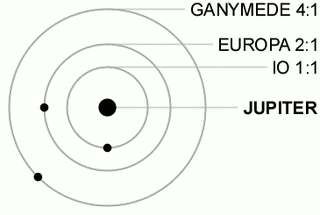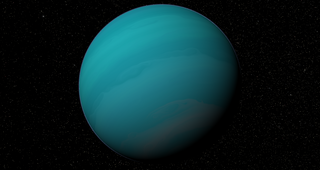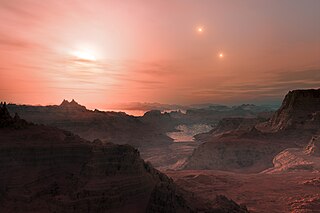
In celestial mechanics, orbital resonance occurs when orbiting bodies exert regular, periodic gravitational influence on each other, usually because their orbital periods are related by a ratio of small integers. Most commonly, this relationship is found between a pair of objects. The physical principle behind orbital resonance is similar in concept to pushing a child on a swing, whereby the orbit and the swing both have a natural frequency, and the body doing the "pushing" will act in periodic repetition to have a cumulative effect on the motion. Orbital resonances greatly enhance the mutual gravitational influence of the bodies. In most cases, this results in an unstable interaction, in which the bodies exchange momentum and shift orbits until the resonance no longer exists. Under some circumstances, a resonant system can be self-correcting and thus stable. Examples are the 1:2:4 resonance of Jupiter's moons Ganymede, Europa and Io, and the 2:3 resonance between Neptune and Pluto. Unstable resonances with Saturn's inner moons give rise to gaps in the rings of Saturn. The special case of 1:1 resonance between bodies with similar orbital radii causes large planetary system bodies to eject most other bodies sharing their orbits; this is part of the much more extensive process of clearing the neighbourhood, an effect that is used in the current definition of a planet.

Gliese 876 is a red dwarf star 15.2 light-years away from Earth in the constellation of Aquarius. It is one of the closest known stars to the Sun confirmed to possess a planetary system with more than two planets, after GJ 1061, YZ Ceti, Tau Ceti, and Wolf 1061; as of 2018, four extrasolar planets have been found to orbit the star. The planetary system is also notable for the orbital properties of its planets. It is the only known system of orbital companions to exhibit a near-triple conjunction in the rare phenomenon of Laplace resonance. It is also the first extrasolar system around a normal star with measured coplanarity. While planets b and c are located in the system's habitable zone, they are giant planets believed to be analogous to Jupiter.

Gliese 436 is a red dwarf located 31.9 light-years away in the zodiac constellation of Leo. It has an apparent visual magnitude of 10.67, which is much too faint to be seen with the naked eye. However, it can be viewed with even a modest telescope of 2.4 in (6 cm) aperture. In 2004, the existence of an extrasolar planet, Gliese 436 b, was verified as orbiting the star. This planet was later discovered to transit its host star.

Gliese 581b or Gl 581b is an exoplanet orbiting within the Gliese 581 system. It is the first planet discovered of three confirmed in the system so far, and the second in order from the star.

Gliese 876 d is an exoplanet 15.2 light-years away in the constellation of Aquarius. The planet was the third planet discovered orbiting the red dwarf Gliese 876, and is the innermost planet in the system. It was the lowest-mass known exoplanet apart from the pulsar planets orbiting PSR B1257+12 at the time of its discovery. Due to its low mass, it can be categorized as a super-Earth.

Gliese 876 c is an exoplanet orbiting the red dwarf Gliese 876, taking about 30 days to complete an orbit. The planet was discovered in April 2001 and is the second planet in order of increasing distance from its star.

Gliese 876 b is an exoplanet orbiting the red dwarf Gliese 876. It completes one orbit in approximately 61 days. Discovered in June 1998, Gliese 876 b was the first planet to be discovered orbiting a red dwarf.

Gliese 436 b is a Neptune-sized exoplanet orbiting the red dwarf Gliese 436. It was the first hot Neptune discovered with certainty and was among the smallest-known transiting planets in mass and radius, until the much smaller Kepler exoplanet discoveries began circa 2010.

Gliese 581d was a candidate extrasolar planet orbiting within the Gliese 581 system, approximately 20.4 light-years away in the Libra constellation. It was the third planet claimed in the system and the fourth or fifth in order from the star. Multiple subsequent studies found that the planetary signal in fact originates from stellar activity, and thus the planet does not exist.

A Super-Earth is a type of exoplanet with a mass higher than Earth's, but substantially below those of the Solar System's ice giants, Uranus and Neptune, which are 14.5 and 17 times Earth's, respectively. The term "super-Earth" refers only to the mass of the planet, and so does not imply anything about the surface conditions or habitability. The alternative term "gas dwarfs" may be more accurate for those at the higher end of the mass scale, although "mini-Neptunes" is a more common term.
Gliese 849, or GJ 849, is a small, solitary star in the equatorial constellation of Aquarius. It has a reddish hue and is invisible to the naked eye with an apparent visual magnitude of 10.41. The distance to this star is 28.8 light-years based on parallax, but it is drifting closer to the Sun with a radial velocity of −15.3 km/s. It has a pair of confirmed gas giant companions.
Gliese 674 b is an extrasolar planet approximately 15 light years away in the constellation of Ara. This planet orbits tightly around Gliese 674. It is a sub-Neptune-or-Uranus-mass planet either gaseous or rocky. It orbits as close as 0.039 AU from the star and takes only 4.6938 days to orbit. This planet has a similar eccentricity to Mercury (e=0.2). The discovery of the planet was announced on January 7, 2007 by using the HARPS spectrograph mounted on the ESO's 3.6 meter telescope at La Silla, Chile.

A hot Neptune or Hoptune is a type of giant planet with a mass similar to that of Uranus or Neptune orbiting close to its star, normally within less than 1 AU. The first hot Neptune to be discovered with certainty was Gliese 436 b in 2007, an exoplanet about 33 light years away. Recent observations have revealed a larger potential population of hot Neptunes in the Milky Way than was previously thought. Hot Neptunes may have formed either in situ or ex situ.

Gliese 667 Cc is an exoplanet orbiting within the habitable zone of the red dwarf star Gliese 667 C, which is a member of the Gliese 667 triple star system, approximately 23.62 light-years away in the constellation of Scorpius. The exoplanet was found by using the radial velocity method, from radial-velocity measurements via observation of Doppler shifts in the spectrum of the planet's parent star.

Gliese 180, is a small red dwarf star in the equatorial constellation of Eridanus. It is invisible to the naked eye with an apparent visual magnitude of 10.9. The star is located at a distance of 39 light years from the Sun based on parallax, and is drifting closer with a radial velocity of −14.6 km/s. It has a high proper motion, traversing the sky at the rate of 0.765 arcseconds per year.
GJ 3470 is a red dwarf star located in the constellation of Cancer, 96 light-years away from Earth. With a faint apparent magnitude of 12.3, it is not visible to the naked eye. It hosts one known exoplanet.
Gliese 367 is a red dwarf star 30.7 light-years from Earth in the constellation of Vela. It is suspected to be a variable with amplitude 0.012 stellar magnitude and period 5.16 years. A stellar multiplicity survey in 2015 failed to detect any stellar companions to Gliese 367. It hosts three known exoplanets, Gliese 367 b, c & d.















